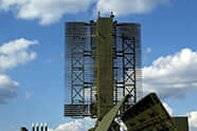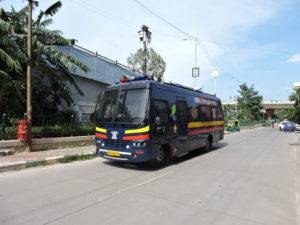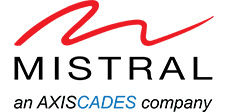Introduction
Over the past few years, terrorism has put at risk the safety and security of citizens and infrastructure of the country. Security and intelligence agencies across the country have been working on addressing these challenges, both pre-emptively and as a crisis unfolds, by using the latest developments in technology. This brief looks at how a Mobile C4ISR platform can be used to handle tactical operations to handle an emergency situation or a terror attack.
The situation
There are two critical requirements for setting up a tactical operation in case of an emergency situation or a terror attack.
The first is to set up a central command and control close to the situation site that receives and assimilates all the relevant data w.r.t to the situation and aids in decision-making and taking the necessary action.
The second requirement is to have the necessary sensors equipped with corresponding delivery platforms at the site for capturing various aspects of the situation and sending it to the central command and control set-up for necessary decision-making.
The Mobile C4ISR platform
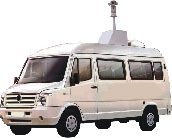 The Mobile C4ISR platforms are a range of unique vehicles for law enforcement agencies (police, para-military), Special Forces teams, defense, and private security agencies. These are easily deployable solutions targeted at requirements such as VIP security, public events (sports, entertainment shows, and political rallies), law and order control, emergency/disaster management, tactical security operations and critical infrastructure protection.
The Mobile C4ISR platforms are a range of unique vehicles for law enforcement agencies (police, para-military), Special Forces teams, defense, and private security agencies. These are easily deployable solutions targeted at requirements such as VIP security, public events (sports, entertainment shows, and political rallies), law and order control, emergency/disaster management, tactical security operations and critical infrastructure protection.
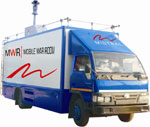 The solution consists of a customized vehicle equipped with either or all of the following: IP video surveillance equipment, video management and analytics, command & control modules and monitoring stations. These help surveillance personnel to quickly deploy surveillance sensors, map them on a cartographic data and assign responsibility to response teams based on events captured by the system. This is an ideal solution for deployment for law and order control, critical infrastructure protection and low-scale emergency/disaster management situations. For deployment during high-intensity law and order situations, terrorist attacks and high-scale emergency/disaster management situations, the Mobile C4ISR can provide an Emergency Operations Centre (EOC) capability. In addition to IP surveillance equipment (video and other sensors), video management, analytics and the complete command & control sub-system, it can provide a live-in facility for operating personnel and has the option of being designed to be made explosion-proof.
The solution consists of a customized vehicle equipped with either or all of the following: IP video surveillance equipment, video management and analytics, command & control modules and monitoring stations. These help surveillance personnel to quickly deploy surveillance sensors, map them on a cartographic data and assign responsibility to response teams based on events captured by the system. This is an ideal solution for deployment for law and order control, critical infrastructure protection and low-scale emergency/disaster management situations. For deployment during high-intensity law and order situations, terrorist attacks and high-scale emergency/disaster management situations, the Mobile C4ISR can provide an Emergency Operations Centre (EOC) capability. In addition to IP surveillance equipment (video and other sensors), video management, analytics and the complete command & control sub-system, it can provide a live-in facility for operating personnel and has the option of being designed to be made explosion-proof.
Sensors Delivery Platforms
Traditional delivery platform for most sensors is within a fixed enclosure at a location, and transmission of the captured data within its range-of-surveillance. While this arrangement works fine for fixed surveillance requirements within a defined surveillance area and known potential objects of interest, in the case of tactical operations where the conditions in an area of surveillance are in a state of constant flux, or where operational considerations require more detailed surveillance information at short notice, new modes of sensor delivery platforms are needed, in order to deliver the required surveillance information.
Some of the sensor delivery platforms, ideally suited for tactical operations are listed below:
Wireless Fixed IP cameras
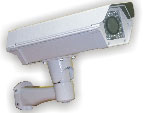 The Mobile C4ISR platform will be equipped with Wi-Fi IP cameras that are powered by Li-polymer battery-packs that provide several hours of power to the cameras. Spare battery-packs are available in the vehicle, in case usage extends beyond the capacity of the primary battery-packs. The cameras are designed for outdoor use and come with IP66 enclosures. They are equipped with IR Illuminators for surveillance in no-/low-light conditions. These wireless cameras can be easily set-up around the premises that is being monitored in a short span of time and the video captured by these cameras are streamed to the Mobile C4ISR platform for further action and decision-making.
The Mobile C4ISR platform will be equipped with Wi-Fi IP cameras that are powered by Li-polymer battery-packs that provide several hours of power to the cameras. Spare battery-packs are available in the vehicle, in case usage extends beyond the capacity of the primary battery-packs. The cameras are designed for outdoor use and come with IP66 enclosures. They are equipped with IR Illuminators for surveillance in no-/low-light conditions. These wireless cameras can be easily set-up around the premises that is being monitored in a short span of time and the video captured by these cameras are streamed to the Mobile C4ISR platform for further action and decision-making.
PTZ cameras mounted on the Mobile C4ISR platform
 The PTZ cameras with 30x+ zoom can be mast-mounted on the roof of the vehicle providing a 360 degree, telephoto coverage on the location under surveillance; for detailed monitoring of specific incidents. The PTZ cameras can be replaced with thermal cameras, optical cameras, or in combo variants. The optical cameras come with integrated IR Illuminators that aid in surveillance in no-/low-light conditions.
The PTZ cameras with 30x+ zoom can be mast-mounted on the roof of the vehicle providing a 360 degree, telephoto coverage on the location under surveillance; for detailed monitoring of specific incidents. The PTZ cameras can be replaced with thermal cameras, optical cameras, or in combo variants. The optical cameras come with integrated IR Illuminators that aid in surveillance in no-/low-light conditions.
Wearable Head-mounted cameras
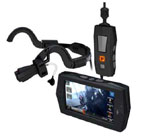 There are several head/body-mounted camera solutions available in the market, and a typical solution would be as follows. These can be worn by the tactical ground force team entering the situation premises, and the images captured by the head/body-mounted camera can be streamed over wireless to the Mobile C4ISR platform stationed close-by in real-time. Based on the video received, the back-end operations team can take decisions like deploying additional resources, mapping and identifying the situation instigator(s) using the existing database and giving necessary action orders back to the ground force team.
There are several head/body-mounted camera solutions available in the market, and a typical solution would be as follows. These can be worn by the tactical ground force team entering the situation premises, and the images captured by the head/body-mounted camera can be streamed over wireless to the Mobile C4ISR platform stationed close-by in real-time. Based on the video received, the back-end operations team can take decisions like deploying additional resources, mapping and identifying the situation instigator(s) using the existing database and giving necessary action orders back to the ground force team.
Source: www.taser.com
Thermal cameras mounted on helicopter
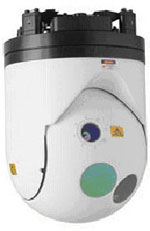 |
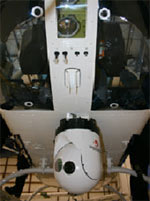 |
Cameras mounted on helicopters can be used to capture people movement, ammunition and other equipment location within the premises where an incident has occurred. This information is streamed using RF to the Mobile C4ISR platform. The monitoring personnel can use this information to the ground forces and aid in effective handling of the situation.
Source: www.wescom.com
Advanced Sensors
The Mobile C4ISR platform can also be equipped with advanced sensors like pressure transducers, heat seeking sensors, miniature cameras and covert audio devices. These advanced sensors can be quickly deployed at the situation site and would transmit the data over RF to the back-end operations in Mobile C4ISR platform team to aid in decision making.
Heat seeking sensors: Heat‐seeking use infrared radiation to detect equipment or humans hidden in foliage or complex urban environments.
Pressure Sensors: Pressure sensors can be used to sense the decay of pressure due to a system leak.
Miniature cameras and audio recording devices: Can be used to capture information in a covert way at the situation venue to help in tactical decisions.
Command & Control
The Mobile C4ISR platform would be equipped with a command & control module that provides a group of functions for integrated situation management. The system has three modules that interact with each other, and can also be used independently:
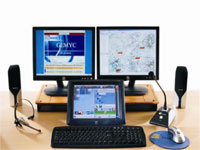 Cartography mapping and resource locator: GIS and AVL module allows resources (ground forces and sensors) and incidents to be mapped on to cartographic data, and tracked in real-time. It allows cartographic data from different sources to be used, along with custom interpretations. For example, in the case of a terrorist attack, a map of the situation site can be used and all the resources, that is the ground forces and sensors deployed and the data received from the sensors, can be displayed on this map to enable identification of the actual location of each incident. In addition, a cartography map of the city or of the area surrounding the situation site can be used to show all the resources available in that area on the map in case additional resources need to be quickly deployed.
Cartography mapping and resource locator: GIS and AVL module allows resources (ground forces and sensors) and incidents to be mapped on to cartographic data, and tracked in real-time. It allows cartographic data from different sources to be used, along with custom interpretations. For example, in the case of a terrorist attack, a map of the situation site can be used and all the resources, that is the ground forces and sensors deployed and the data received from the sensors, can be displayed on this map to enable identification of the actual location of each incident. In addition, a cartography map of the city or of the area surrounding the situation site can be used to show all the resources available in that area on the map in case additional resources need to be quickly deployed.
Communications matrix: Multi-protocol switch allows user to receive and patch voice calls between protocols such as V/U/HF, GSM, CDMA, PSTN, Tetra and VoIP. The touch-screen application is user-friendly, allowing drag and drop of caller icons over the protocols to be patched. This allows the operator to quickly patch different resources communication on different channels, saving valuable time and avoiding any possibility of miscommunication.
Call-taking and Dispatch: The easy-to-use Computer-Aided Dispatch (CAD) application with touch-screen interface and dual displays, allows the operator to receive calls, record details of an incident, and initiate necessary action.
The schematic below showcases the use of the Mobile C4ISR platform for a tactical operation. The output streams for the wireless IP, thermal, and long-range PTZ cameras sent over wireless/RF are monitored in the Mobile C4ISR platform; along with cartography representation. In addition, the multi-protocol communication switch enables different communication channels to be integrated; aiding in assigning resources and responsibility for specific events triggered using the call taking, dispatch and cartography modules.
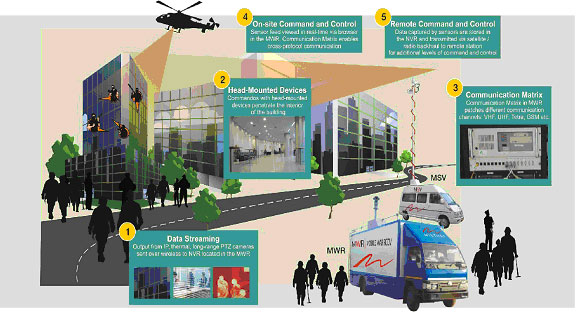 |
| Figure 2: Mobile C4ISR platform for a tactical operation |
Conclusion
The benefits of using a Mobile C4ISR platform for tactical operations are as follows.
- It enables detailed and real-time information to be made available at the incident site, allowing officials to view a Common Operational Picture of the operation and thereby plan an efficient operation
- Helps in managing the response such that multiple agencies and teams work in a co-ordinated and effective manner
- Allows real-time information to be made available to the ground force, so that they are well-prepared to handle any incident or situation that they may come to face
- Allows up-to-date information to be made available to media/public-facing officials, so that only validated and approved information is released for consumption
Mistral offers expertise in integrating the Mobile C4ISR solutions on various platforms. It sells a range of Mobile C4ISR platforms, built on vehicles such as vans, LCVs, and containers that can be deployed for various operations.

